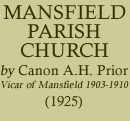< Previous | Contents | Next >
How the Parish Church of SS. Peter and Paul Grew.
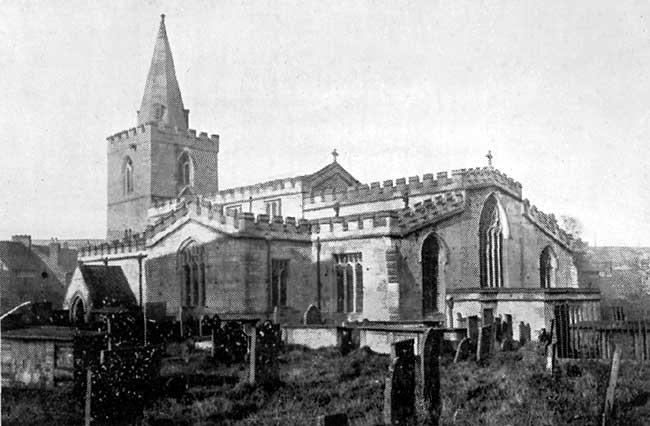
PLATE I. Mansfield Parish Church, from the South-East.
The remains of the ancient Forest of Sherwood (B) rank second to none of the kind in England. It is to this, as a rule, that the traveller to Mansfield is bent, and having secured his means of transit at the picturesque Swan Hotel, he is to be pardoned for thinking that nothing of great interest can lie embedded in so unpicturesque a town. But as the oyster has the pearl, so Mansfield-in-Shirewood has its Parish Church.
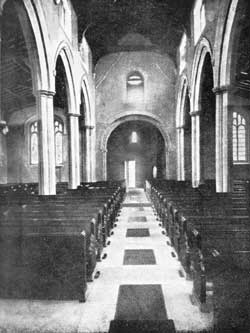
PLATE III. Interior. East Face of Norman Tower, Ale Door, Perpendicular Window, North Aisle.
It is not for the tourist alone, however, that we attempt a history of the only object of real interest in the Royal Town, but chiefly for the many who, week by week, worship in our venerable Church, and yet, perhaps, are deaf to the stones which cry out from the walls. Rickman, in 1825, remarked: "The Church at Mansfield deserves minute attention." He saw it with the tower covered with stucco (C), the interior blocked with hideous pews (the property of certain householders), a cloud of galleries, the beautiful arcade so cut through and mutilated that the wonder is that it supported the roof at all, and yet amid all this disfigurement he, the great Gothic architect, recognised the Church as an object of interest and beauty.
It scarcely needs the entry in Domesday (vol. I., p. 281): "here are 2 churches and 2 priests " (D) to attest its Saxon origin, for a glance at the lower stories of the tower will satisfy the most sceptical of its antiquity (E). The only fragment, however, of the Saxon Church is the lowest weathering on the East side of the present tower. (We say "lowest" advisedly, for note there are three weatherings, relics of former naves.) It would be a Church constructed probably of wattles, with a roof of stone slabs pegged on with deer-bones, occupying much the same ground as the nave and chancel to-day.
William Rufus, by way of endowing the newly-founded (1092) See of Lincoln, gave the Church, with what belonged to it in the time of Edward the Confessor, to the Church of S. Mary of Lincoln and to Robert the Bishop (F) and all his successors in perpetual possession (G). The date of this gift would be between 1093, when Robert Chancellor of England, brother of Hugh Bishop of Bayeux, became second Bishop of Lincoln, and 1100, the date of William's death. The sentence, "with what belonged to it," implies antiquity and importance. Mansfield was a Royal Manor. To it were attached mesne manors. The Churches in these mesne manors would be chapelries to the Mother Church (H).
One result of this royal gift was, of course, the reduction of the parish priest from a rector to a vicar, and the alienation of the greater tithes (amounting to about £300 of present money).
The Early Norman tower was almost immediately added to the humble Saxon Church. Towers were very commonly built by the Normans for defence. The existing roof of the spiral staircase to the belfry, looks as though it had been constructed by Saxon workmen, and the position of our tower at the foot of Toothill Lane (I), within a stone's throw of the British track, Leeming Lane (J), at the junction of four cross-roads (one of which was Sewsterne Lane leading from the Fosse Way), and by the ford over the river (K), suggests the theory that the Norman builders had an eye to something beyond the mere housing of the Curfew (L).
The gargoyles now elevated to the summit of the Decorated top storey, once adorned the plain parapet, of the squat Norman tower.
Up to the time of the skilful restoration of the Church in 1870 the early unchamfered Norman arches, looking into the nave, were hidden away; a sudden fall of brickwork left the lower one revealed in all its beauty and simplicity. The higher archway probablv served for the ringer to know when to sound the sanctus bell at the elevation of the Host.
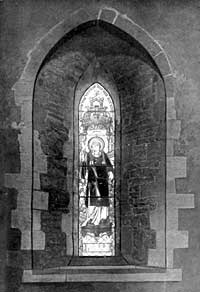
PLATE IV. Early English Lancet in South Aisle.
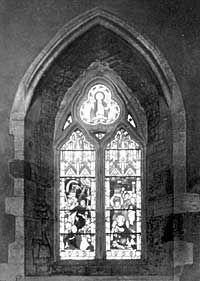
PLATE V. Early Decorated Window in North Aisle, probably removed here from the East end of this Aisle in 1420.
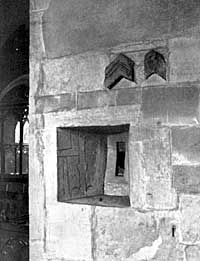
PLATE VIII. Squint between South Chapel and Chancel, constructed partly of a Mason's Tombstone. Note the zig-zag Moulding of Norman Chancel.
But not for long did the parishioners remain satisfied with their Saxon Church. The fragment of chevron moulding (portion of an outer string course), by the Vestry door, of date about 1135 (Plate VIII.), is evidence that earlier in the century the Saxon nave could not have been demolished, and that it was not until perhaps 50 years after the erection of the Norman tower, that a Norman nave and chancel and N. aisle were substituted for the wooden Church. The substantial nature of the improvement may be judged from the present thickness of the pierced chancel walls.
The growth of the town, owing to the proximity of the Court at Clipstone necessitated an enlargement, and about 1200 the North aisle was enlarged. At the West end of this aisle (where Rickman noticed " a particularly handsome three-light perpendicular window of very good mouldings") may be seen, on the outside, jambs of 2 former lancets, and the remaining Early English lancet, looking up Toothill Lane (Plate IV.), tells its own tale and speaks of the period when the enlargement was carried out. Sutton-in-Ashfield, at one time perhaps a Chapelry of Mansfield, was similarly treated, but a little earlier than this— say, 1170.
Another century was not allowed, however, to pass away without a still further extension. In the time of the early Edwards, Churchmen were nothing if not builders; it was the golden age of architecture. There must be more space, more altars, and an exit on the South side through which the corpse, brought into Church by the North door, might be carried out to burial. And so to gratify the love of building, late on in XIII. Century, the masons are set to work on the present beautiful nave arcades. They raise the tower another storey (M) in order to carry the high pitched roof, and throw out the South aisle with its diagonal buttress (N).
The exact date of this extensive transformation and extension came to light quite accidentally by publication in June, 1904, of Robert White's Dukery Records, in which (O) he says : "On April 23, 1286, Temp. Ed I. and Queen Eleanor an indulgence was granted to those who would visit the Church of Mansfield at the dedication of two altars therein, viz., one that of the Blessed Mary and S. Katherine (P) and that of S. William (Q) and S. Margaret (R). These altars would doubtless be at the East ends of the side aisles, and the windows which stood above them (see Plate V.) are very possibly the very two in the North aisle to-day, which sooner than destroy, the builders inserted there 150 years later, when the Perpendicular chapels were added, and the present arches into the chapels substituted for the windows removed.
The next enlargement was the product of two great social movements:—
1. The Crusader returning from the Holy Land enamoured with the frescoes and stained glass which adorned Continental and Eastern Churches, aroused a desire in England for more light. In many places the huge Perpendicular window which gave scope for artistic work and coloured glass was substituted for the elegant Decorated window of the XIV. century (S).
2. Monasteries which hitherto had absorbed endowments were on the decline. Rich men preferred endowing a chantry of which their heirs might retain the patronage. Consequently side altars, at which chantry priests might officiate, were multiplied. So at Mansfield, for the accommodation of more side altars (T), to facilitate processions, which were a feature of the times, and to give scope for a greater area of painted glass, the two side chapels, which necessitated the piercing of the chancel walls, were added somewhat early in the XV. century.
Little more remains to be added concerning the fabric of the building. The battlements (U) and clerestory, which necessitated yet a third roof, are characteristic of early Tudor times.
After the Restoration, the genius of Sir C. Wren and the too short-lived enthusiasm of English Churchmen, supplied a fresh impetus for Church building. It was at this period the Tower was capped with the Spire, which has carved upon it in three places the date 1669.
When the ancient weathercock was repaired in 1897, the two following inscriptions were found carved on either side of the bird's tail:—
| Repaired 1687 | John Firth, Vicar, | |
| John Farrer, | } | |
| } Churchwardens. | ||
| Wm. Green, | } | |
| Repaired 1793 | John Durham, Vicar, | |
| Geo. Vickers, | } | |
| } Churchwardens. | ||
| Jos. Walker, | } |
For the beauty of the present roof timbers, as indeed for the whole of the conservative restoration effected in 1870, there is the greatest possible credit due to the architect, Mr. Smith, of the Adelphi, London.
To one who will take his stand at the bottom of Toothill Lane, the growth and expansion of the Church through the five great periods of architecture will reveal itself at a glance. There is the Norman tower, the Early English lancet and North door, the Decorated windows, the Perpendicular chapels, and the Classical spire. Apparently there have been few generations but have done something towards the enlargement or beautifying of the Church. May we each one, in our day, contribute somewhat to the building up of Christ's Church on earth.
(A) In Domesday: Mamesfelde. cp. Manchester—Mameceaster.
(B) The Forest extended from Warsop to Nottingham, and contained nearly 100,000 acres. Mr. W. Wylde, of Nettleworth, who died 1780, aged 83, recollected one continuous wood from Nottingham to Mansfield (Harrod, p. 17). The celebrated Duke of Newcastle lamented nothing so much as the destruction of his Forests by the Parliamentarians (Cavalier in Exile, p. 90).
(C) Pebble-dashed stucco—precisely similar to that on the ancient stone summer-house, standing to-day in Mr. Holt's timber yard. Note— This hip-roofed building stands on ground once leased from Southwell Minster by the Vicar and Churchwardens.
(D) Skegby was a Berewic (hamlet) of Mansfield (Thoroton ii., 309), and had a Church and Priest. Woodhouse was a Chapelry up to and beyond 1582 (P. Registers), but it is unlikely it had a Church at Domesday Survey.
(E) Kirkgate, the old name for Church Street (Manor Rolls, 6th September, 1580), is proof a Church stood here in time of the Danes.
(F) Before 1240 the Church had passed from the Bishop to the Dean. (Dr. Cursham's letter in British Museum.)
(G) Dugdale, Mon. Ang. : Vol. VI., p. 1271 ; Ed. 1846— For my father, mother, and my own soul, Et capellas quce sunt in berewics qua adjacent, Praedictis quatuor maneriis, Hoc donum factum est die crastina, qua Anselmus Archiepiscopus meus ligeus homo factus est.
(H) Edenstow, Carberton, South Leverton, and Wellow, all belonged to the Manor of Mansfield, and went over to Lincoln at the same time as the Mother Church (Torre MS.).
(I) Toothill—A watch tower. (J) Leeming—a stony way—the road on the rock. There are two other Leeming Lanes in England.
(K) There were stepping stones until 1776 when the Bridge was built.
(L) Mr. W. Stevenson, vice-president of the Thoroton Society, gives it as his opinion that originally the Norman Tower was without an outside door, and that the present West door was the North door of the later Norman Nave, which was inserted in the Tower when to the Norman Nave was added the North Aisle. Note the terminals of the label mould.
(M) Rickman notes: "The good two-light window in the belfrey storey."
(N) Note the incised slabs built into the buttresses against the South Aisle.
(O) P. 389. (p) S. Katherine, martyred at Alexandria, A.D. 307. Teversall, amongst earliest of Churches, dedicated to her name in England. (U) S. William, great grandson of William I., Archbishop of York in 1143, deprived 1147, restored 1153, perhaps poisoned 1154. Buried at York and accounted Martyr.
(R) S. Margaret, not likely to be the Scottish Saint, but probably the Virgin Martyr of Antioch in Pisidia, whom we commemorate on July 20th (see Hone's Every Day Book). She was a favourite Saint with women in the Middle Ages.
(S) The great West Window at Southwell, substituted for the original Norman ones about this period.
(T) As a rule only one Mass daily permitted at any given Altar. An Ancient Canon said a Church should have only one Altar, and so Chantrey Chapels were fashioned to look as much as possible like separate small Churches.
(U) Battlements, characteristic of English Church architecture. More suited for fortification on dwellings than on Churches.
